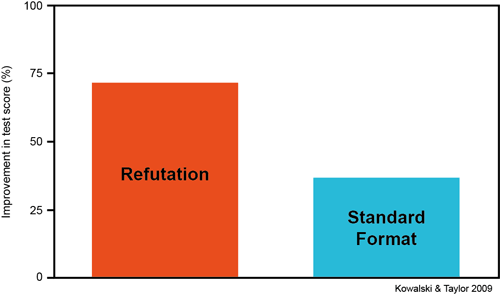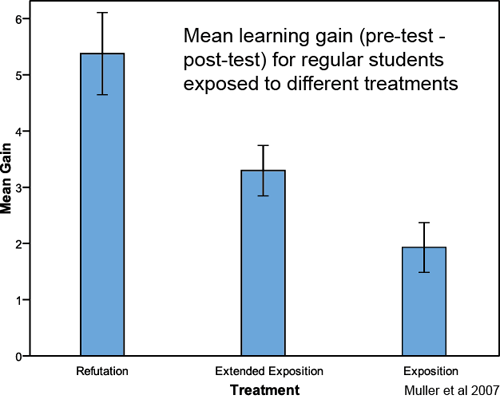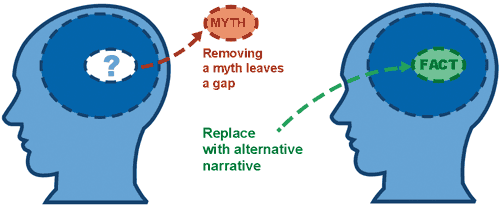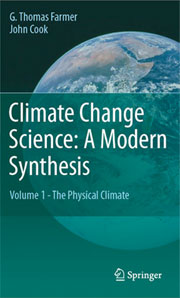
An interesting discussion arose in Tom Farmer’s latest blog post about our textbook Climate Change Science: A Modern Synthesis. One of the commenters questioned whether certain sections should have been included in the textbook. The two chapters he referred to were Chapter 23: Understanding Climate Change Denial and Chapter 24: Rebuttals to Climate Myths. I would argue that not only are such chapters appropriate, they are essential to a comprehensive climate education. In fact, I would go further. Addressing misinformation in the classroom is not just a necessary evil – it’s actually an opportunity that educators should be embracing.
Firstly, it’s important to understand that education isn’t just a matter of downloading new information into student’s heads. An important aspect is correcting misperceptions. Jonathan Osborne sums it up nicely when he says "Comprehending why ideas are wrong matters as much as understanding why some ideas may be right." Another famous educator provides an even pithier quote on the importance of correcting misperceptions.
What is the best way for teachers to dispel misconceptions? Is it enough to simply teach students the facts? It turns out no. A study conducted with 1st year psychology students found that lectures explicitly refuting misconceptions were twice as effective as the standard lecture format in reducing misconceptions. Teachers need to directly challenge false ideas to provoke students into examining their preconceptions.

Similarly, a study of physics students found that directly debunking physics misconceptions was considerably more effective than exposition style lectures that merely explained the correct physics. What's interesting about this particular research was students were more confident about their physics knowledge after exposition lectures but scored worse. After a refutational lecture, they were less confident about their knowledge but scored better. This shows that misconceptions have two negative influences. They interfere with correct information and they also instill a false sense of knowing. Debunking teaches science but it also teaches a little humility.

So addressing misinformation head-on is the most effective way of reducing students’ misperceptions. But there is also an exciting educational opportunity in debunking myths. When you debunk a myth, you create a gap in people’s understanding of the world. If you don't fill that gap, the myth will come back to fill the hole. You fill the gap by creating an alternative explanation. The structure of an effective debunking is to create a gap, then fill the gap.

There is a highly recommended book on communication by the Heath brothers, Made to Stick. The authors identify one of the traits of “sticky” ideas that are compelling and memorable. A compelling message arouses people's curiosity then satisfies their curiosity. The way to do this is by creating gaps in people's knowledge then filling those gaps. Sound familiar? The very nature of debunking myths lends itself to creating engaging, "sticky" material that raises questions in people's minds then answers the questions.
 This is why college professors such as Daniel Bedford from Weber State University, Utah, are addressing misinformation in their classrooms as a way of teaching critical thought and the nature of science. Given that more lecturers and educators are recognising the importance of addressing misinformation, Tom and I decided to include the most detailed treatment of climate misinformation and the phenomenon of climate change denial in a climate textbook (to our knowledge). Chapter 23: Understanding Climate Change Denial goes into detail on the characteristics of denial, what is driving climate denial (essential to understanding the controversy) and how to respond to misinformation. Chapter 24: Rebuttals to Climate Myths features concise rebuttals to the most popular climate myths, with each rebuttal adhering to the structure recommended in the Debunking Handbook. If any lecturers, professors or educators are interested in receiving a sample copy of the chapter Understanding Climate Change Denial, feel free to contact me.
This is why college professors such as Daniel Bedford from Weber State University, Utah, are addressing misinformation in their classrooms as a way of teaching critical thought and the nature of science. Given that more lecturers and educators are recognising the importance of addressing misinformation, Tom and I decided to include the most detailed treatment of climate misinformation and the phenomenon of climate change denial in a climate textbook (to our knowledge). Chapter 23: Understanding Climate Change Denial goes into detail on the characteristics of denial, what is driving climate denial (essential to understanding the controversy) and how to respond to misinformation. Chapter 24: Rebuttals to Climate Myths features concise rebuttals to the most popular climate myths, with each rebuttal adhering to the structure recommended in the Debunking Handbook. If any lecturers, professors or educators are interested in receiving a sample copy of the chapter Understanding Climate Change Denial, feel free to contact me.
Posted by John Cook on Friday, 8 March, 2013
 |
The Skeptical Science website by Skeptical Science is licensed under a Creative Commons Attribution 3.0 Unported License. |